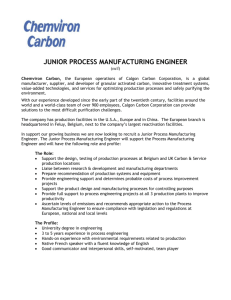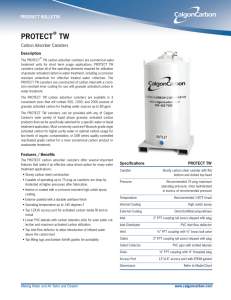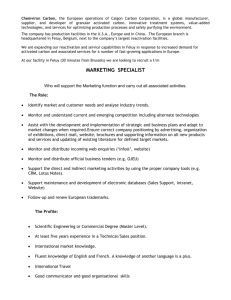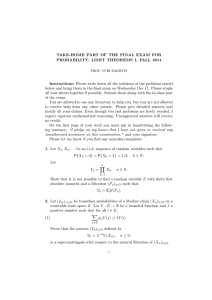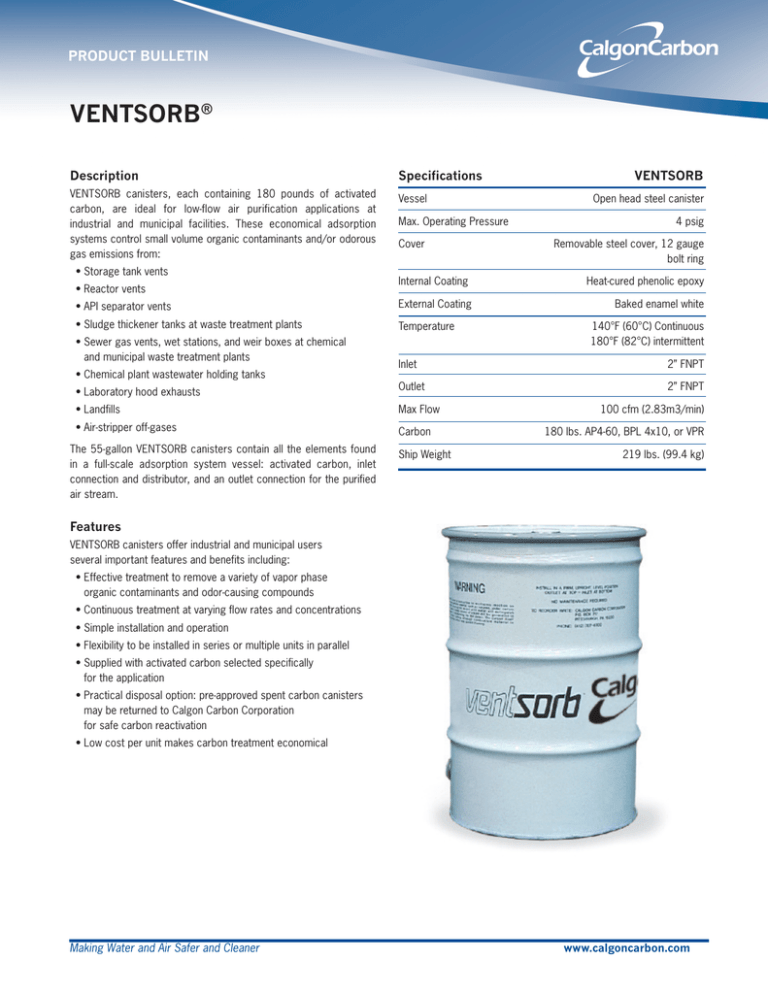
PRODUCT BULLETIN
VENTSORB®
Description
Specifications
VENTSORB canisters, each containing 180 pounds of activated
carbon, are ideal for low-flow air purification applications at
industrial and municipal facilities. These economical adsorption
systems control small volume organic contaminants and/or odorous
gas emissions from:
Vessel
Max. Operating Pressure
Cover
VENTSORB
Open head steel canister
4 psig
Removable steel cover, 12 gauge
bolt ring
• Storage tank vents
• Reactor vents
Internal Coating
• API separator vents
External Coating
• Sludge thickener tanks at waste treatment plants
Temperature
• Sewer gas vents, wet stations, and weir boxes at chemical
and municipal waste treatment plants
Heat-cured phenolic epoxy
Baked enamel white
140°F (60°C) Continuous
180°F (82°C) intermittent
Inlet
2” FNPT
Outlet
2” FNPT
• Chemical plant wastewater holding tanks
• Laboratory hood exhausts
• Landfills
Max Flow
• Air-stripper off-gases
Carbon
The 55-gallon VENTSORB canisters contain all the elements found
in a full-scale adsorption system vessel: activated carbon, inlet
connection and distributor, and an outlet connection for the purified
air stream.
Ship Weight
100 cfm (2.83m3/min)
180 lbs. AP4-60, BPL 4x10, or VPR
219 lbs. (99.4 kg)
Features
VENTSORB canisters offer industrial and municipal users
several important features and benefits including:
• Effective treatment to remove a variety of vapor phase
organic contaminants and odor-causing compounds
• Continuous treatment at varying flow rates and concentrations
• Simple installation and operation
• Flexibility to be installed in series or multiple units in parallel
• Supplied with activated carbon selected specifically
for the application
• Practical disposal option: pre-approved spent carbon canisters
may be returned to Calgon Carbon Corporation
for safe carbon reactivation
• Low cost per unit makes carbon treatment economical
Making Water and Air Safer and Cleaner
www.calgoncarbon.com
Applications
Chemical, petrochemical, food, pulp and paper, and many other
industrial plants, along with municipal sewage treatment facilities, are
frequent users of VENTSORB for continuous control of vented
emissions. Examples of user applications include:
Storage Tank Vents
VENTSORB is widely used to control evaporative losses vented from
storage tanks. Typically these vapors are emitted during tank filling
and emptying. In one application, a glycerin manufacturer uses the
canisters to purify ambient air drawn into the storage tanks during
product transfer. The adsorption process helps prevent contamination
of the company’s glycerin product. The VENTSORB units provide
greater than six months of service for this application.
Reactor Vents
A pesticide manufacturer is using multiple VENTSORB on five
reactor vessels to control trace amounts of odorous methylamine and
diethylamine (by-products of a caustic scrubbing process). Each
VENTSORB unit handles a 30 cfm air stream containing 15 ppm of
amine vapors. The units provide greater than three months of service
for this application.
API Separator Vents
A major refinery uses VENTSORB units to control odorous emissions
from settling basins where oil is separated from wastewater that is
discharged in condensate, blow-down, or drain systems. For this
application, API separators are covered and vented to comply with
local air pollution control regulations. The air stream is pulled through
two VENTSORB units operating in parallel configuration at 100 cfm.
2" FNPT centered in cover
wire & crimp seal
applied to closing ring
12 gauge bolt type
closing ring
353/16"
221/2"
If the VENTSORB will be vented directly to outside air, a U-shaped
outlet pipe or rain hat (such as a pipe tee) is recommended to prevent
precipitation from entering the unit.
VENTSORB canisters operate from a continuous suction across
the vent. The suction can be produced by a blower or by using the
positive pressure inside the tank or process vessel. In many cases,
the pressure or surge of pressure within the tank or vessel is sufficient
to overcome the pressure drop across the canister, eliminating the
need for a blower. Please consult the pressure drop data in this bulletin
for more information.
Maximum recommended air flow through a VENTSORB is 100 cfm. If
higher flows are encountered, plant operators should install two or
more canisters in parallel configuration. When VENTSORB canisters
are used to control vapors from organic solvent storage tanks, the
following precautions are recommended:
• A safety relief valve must be provided. This protects the storage
tank should the VENTSORB become plugged or blocked in any
fashion. Such a vent would open in an emergency situation,
thereby relieving pressure.
• Under appropriate conditions a flame arrestor and/or backflow
preventor must be installed as shown in this bulletin’s storage
tank installation drawing. This prevents backflow of air through
the VENTSORB when the storage tank is empty.
• Pre-wetting the carbon helps dissipate excessive heat that
may be caused by high organic compound concentration
(>0.5 to 1.0 Vol.%).
If VENTSORB canisters are used to control organic emissions
from air-strippers or other high moisture content air streams, Calgon
Carbon Corporation recommends that humidity in the air stream be
reduced to under 50 percent. Lower humidity optimizes adsorptive
capacity of the carbon. In addition, for similar applications that
generate a condensate, Calgon Carbon Corporation recommends
installation of a drain on the inlet piping.
Safety Considerations
drum wall
2" FNPT
C connection
1
1
3 /2"(+ /2" -0")
Installation
VENTSORB canisters are shipped ready for installation. Each canister
is self-supporting and should be placed on a level, accessible area as
near as possible to the emission source. Installation is simple,
requiring just a flexible hose or pipe to connect the vent to the 2-inch
FNPT bottom inlet of the canister.
Making Water and Air Safer and Cleaner
While complying with recommended installation instructions, plant
operators should also be aware of these additional heat-related safety
considerations:
• When in contact with activated carbon, some types of chemical
compounds, such as those from the ketone and aldehyde
families, and some organic acids or organic sulfur compounds,
may react on the carbon surface causing severe exotherms or
temperature excursions. If you are unaware or unsure of the reaction of an organic compound on activated carbon,
appropriate tests should be performed before placing a
VENTSORB in service.
www.calgoncarbon.com
Typical VENTSORB Installation at Storage Tank
2.5
Flame Arrestor
2" Pipe
Hose or Duct
Vacuum Relief
Vent Pipe
Storage
Tank
Pressure Drop, (Inches of Water)
Safety Relief
Pressure Drop
2.0
1.5
1.0
0.5
0.0
0
20
40
Air Flow (cfm)
Backflow
Preventer
VENTSORB®
• Heat of adsorption can lead to severe temperature excursions
at high concentrations of organic compounds. Heating may be
controlled by diluting the inlet air, by time weighting the inlet
concentration to allow heat to dissipate, or by pre-wetting
the carbon.
• Do not use VENTSORB with STI-X carbon in petrochemical or chemical industry applications.
• ST1-X carbon can liberate heat by reacting chemically with
oxygen. To prevent heat within a vessel, the carbon must not
be confined without adequate air flow to dissipate the heat. In
situations where there is insufficient or disrupted air flow through
the vessel, the chemical reaction can be prevented by sealing the
inlet and outlet connections to the vessel.
Return of VENTSORB
Arrangements should be made at the time of purchase to return
canisters containing spent carbon. Calgon Carbon Corporation can
provide instructions on how to sample the spent carbon and arrange
for carbon acceptance testing. The spent carbon is reactivated by
Calgon Carbon Corporation, and all of the contaminants are thermally
destroyed. Calgon Carbon Corporation will not accept VENTSORB
canisters for landfill, incineration, or other means of disposal.
VENTSORB cannot be returned to the company unless the carbon
acceptance procedure has been completed, an acceptance number
provided, and the return labels (included with the unit at the time of
purchase) are attached. VENTSORB must be drained and inlet/outlet
connections must be plugged prior to return to Calgon Carbon
Corporation.
Safety Considerations
For temperatures greater than 140°F, Calgon Carbon recommends
that personnel protection be provided. The form of protection is
determined per the end user’s specific plant practices and standards.
Also note that at elevated temperatures, the paint may discolor.
Making Water and Air Safer and Cleaner
60
80
100
120
Vapor Phase React
Pressure drop through a VENTSORB unit is a function of the process
air flow as shown in the graph. A VENTSORB canister can handle up
to 100 cfm at a pressure drop of less than 2.5 inches of water column. If higher flows or lower pressure drop is needed,
multiple canisters may be installed in parallel operation. The maximum
canister pressure should not exceed 4 psig.
Safety Message
Wet activated carbon preferentially removes oxygen from air. In closed
or partially closed containers and vessels, oxygen depletion may reach
hazardous levels. If workers are to enter a vessel containing carbon,
appropriate sampling and work procedures for potentially low oxygen
spaces should be followed, including all applicable federal and state
requirements.
Calgon Carbon Air Purification Systems
VENTSORB is specifically designed for a variety of small applications.
Calgon Carbon Corporation offers a wide range of carbon adsorption
systems and services for a range of flow rates and carbon usages to
meet specific applications.
Carbon Life Estimate
This table lists the theoretical adsorption capacities for several
compounds. The adsorption capacity for nonpolar organic
compounds increases with the boiling point, molecular weight, and
concentration of the air contaminant. Estimate the life of a VENTSORB
canister for other organic compounds by matching them with
compounds of similar boiling points and molecular weight in this table.
Low molecular weight (less than 50) and/or highly polar compounds
such as formaldehyde, methane, ethanol, etc. will not be readily
adsorbed at low concentrations.
Note: The standard VENTSORB canister contains 180 pounds of
AP4-60 carbon. When removing hydrogen sulfide and mercaptans
from moist air vented from sewage operations, greater efficiency will
be achieved by using a VENTSORB canister which contains specially
impregnated STI-X carbon. A VENTSORB containing STI-X carbon can
remove up to 40 pounds of hydrogen sulfide and 15 pounds of
methyl mercaptan.
www.calgoncarbon.com
Theoretical Capacities*
Pounds Adsorbed per VENTSORB at Given Concentration of Contaminant**
Approximate
Boiling Point (°C)
Molecular
Weight
Lbs. @
10 ppm
Lbs. @
100 ppm
Lbs. @
1,000 ppm
Acrylonitrile
77.3
53.1
8
15
26
Benzene
80.1
78.1
14
22
34
n-Butane
-0.5
58.1
7
10
16
Carbon Tetrachloride
76.8
153.8
45
60
78
Dichloroethylene -1,1
31.7
97.0
16
25
38
Methylene Chloride
40.2
84.9
4
9
19
Freon 114
3.8
170.9
16
26
40
n-Hexane
68.7
86.2
21
27
34
Styrene
145.2
104.1
47
56
65
Toluene
110.6
92.1
35
43
51
Trichloroethylene
87.2
131.4
32
47
67
* Theoretical capacity based on 70° F, 1 atm pressure, less than 50 percent humidity, and 180 pounds of carbon using isotherm data for AP4-60 carbon.
** This information has been generated using Calgon Carbon's proprietary predictive model.
There is no expressed or implied warranty regarding the suitability or applicability of results.
www.calgoncarbon.com
Making Water and Air Safer and Cleaner
Corporate Headquarters
Calgon Carbon Corporation
500 Calgon Carbon Drive
Pittsburgh, PA USA 15205
800.422.7266
412.787.6700
412.787.6713 Fax
European Operations
ChemvironCarbonCorporation
ZoningIndustrielCdeFeluy
B-7181Feluy,Belgium
+32(0)64511811
+32(0)64541591Fax
www.calgoncarbon.com
Copyright© 2012 Calgon Carbon Corporation, all rights reserved.
Asia Operations
CalgonCarbonAsiaPteLtd.
9TemasekBoulevard
#26-02SuntecTowerTwo
Singapore038989
+6562213500
+6562213554Fax
Your local representative
0612

